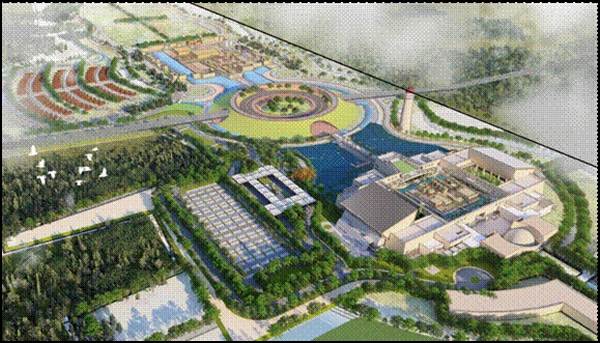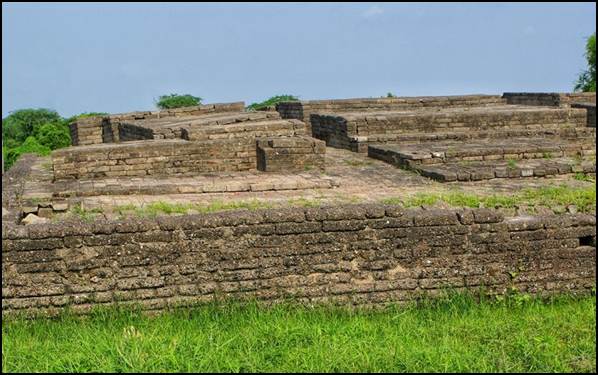Lothal: In a significant decision, the Union Cabinet, chaired by Prime Minister Narendra Modi, has approved the development of the National Maritime Heritage Complex (NMHC) at Lothal, Gujarat. This initiative, led by the Ministry of Ports, Shipping & Waterways, aims to celebrate and showcase India’s extensive maritime heritage, which spans over 4,500 years.
Lothal, a pivotal site in this ancient legacy, is poised for a transformative journey. With the foundation stone laid in March 2019, the NMHC is envisioned to be one of the largest maritime complexes in the world. The project will be completed in two phases, each designed to enhance the visitor experience and educational impact. It will curate and display a rich array of artefacts, from ancient relics to modern treasures, serving as an educational platform that inspires visitors to explore the depths of our maritime history.

This state-of-the-art facility will integrate our past, present, and future maritime endeavours, offering a unique blend of education and entertainment. Through interactive and immersive experiences, visitors will encounter life-sized representations of Lothal’s architecture, allowing them to step into the shoes of ancient mariners and traders. The NMHC promises to be a beacon of knowledge, illuminating the richness of our maritime heritage for generations to come.
Project Overview and Impact
The National Maritime Heritage Complex (NMHC) is a multifaceted project that will encompass several key components, including a museum featuring 14 galleries, a Lothal Town and Open Aquatic Gallery, a Lighthouse Museum, a Bagicha Complex, Coastal State Pavilions, and the Recreation of Lothal City. Additional features will include eco-resorts, a Museuotel, theme-based parks, and a maritime research institute with a hostel. This ambitious undertaking aims not only to boost tourism but also to generate significant employment opportunities and revive local businesses in the region.
Situated near Saragwala village in Lothal, the NMHC will serve as a hub for showcasing and preserving India’s rich and diverse maritime heritage. The proposed project will display artefacts related to ancient shipbuilding, navigational technologies, and historical connections, as well as explore social and cultural links to maritime research frontiers.
Lothal falls within the Dholka Taluka of Ahmedabad district and is conveniently located near National Highway No. 47 and State Highway No. 8, providing excellent road connectivity to major urban centres such as Ahmedabad, Bhavnagar, and Rajkot. Additionally, it lies approximately six kilometres southeast of the Lothal-Bhurkhi railway station on the Ahmedabad-Bhavnagar railway line. The archaeological site is surrounded by three villages: Saragwala, Uteliya, and Gundi, where agriculture is the primary occupation.
To oversee the implementation of the NMHC, the Ministry of Ports, Shipping & Waterways (MoPSW) has appointed the Indian Ports Association as the nodal agency, with the Indian Port Rail Corporation Ltd (IPRCL) serving as the executing agency. The master plan has been crafted by the renowned architecture firm M/s Architect Hafeez Contractor, while the construction of Phase 1A has been entrusted to Tata Projects Ltd. The Government of Gujarat has allocated 400 acres of land for the project’s development and is also responsible for enhancing external infrastructure and part of the basic internal infrastructure.
The development of the NMHC is expected to create approximately 22,000 jobs, with 15,000 direct and 7,000 indirect employment opportunities. The implementation of this complex will not only stimulate economic growth but will also significantly benefit local communities, tourists, researchers, scholars, government bodies, educational institutions, cultural organizations, environmental and conservation groups, and businesses, fostering a vibrant ecosystem that celebrates India’s maritime legacy.
Historical Significance of Lothal
Lothal, a name that combines the Gujarati words “Loth” and “thal,” meaning “the mound of the dead,” is rich in historical importance. This ancient city, dating back to 2400 BCE, grew into a bustling trading port within the Indus Valley Civilization. The archaeological excavations, carried out by the Archaeological Survey of India (ASI) from February 13, 1955, to May 19, 1960, aimed to uncover the remnants of this once-bustling metropolis.

Archaeologists believe Lothal was strategically placed along a major river system that formed part of the old trade route linking Sindh to Saurashtra in Gujarat. The excavations at this site have unearthed an impressive array of artefacts, making it one of the richest archaeological finds in modern India.
As a key player in the Indus Valley Civilization, Lothal showcased features that highlighted its role as a maritime hub. Among the most significant discoveries is the world’s oldest known artificial dock, connected to an ancient course of the Sabarmati River. The site also revealed an acropolis, a lower town, a bead factory, warehouses, and a well-designed drainage system, all of which underscore Lothal’s status as a vital trading city.
The network of canals and dockyards found here shows the advanced planning and skill that marked Lothal’s urban design. Artifacts unearthed at the site suggest that trade may have occurred with distant lands, including Mesopotamia, Egypt, and Persia. The discovery of a complete township, complete with markets and docks, further emphasizes Lothal’s historical importance.
In this context, the National Maritime Heritage Complex (NMHC) will play a crucial role in preserving and showcasing this legacy. It will not only curate and present a diverse array of artefacts, spanning from ancient times to the present but will also inspire the public to explore and learn about India’s glorious maritime heritage.
Cabinet Approval and Development Phases
The National Maritime Heritage Complex (NMHC) is set to unfold in multiple phases, each designed to enhance its offerings and educational impact. The Cabinet has granted in-principle approval for the subsequent phases of the National Maritime Heritage Complex (NMHC), outlining a strategic plan for its development and expansion.
These phases will be funded through voluntary resources and contributions, with execution contingent upon securing the necessary funds. To oversee the development of future phases, a separate society will be established, governed by a Governing Council headed by the Minister of Ports, Shipping & Waterways, in accordance with the Societies Registration Act, 1860. Phases 1A and 1B will be developed using the Engineering, Procurement, and Construction (EPC) model, while Phase 2 will adopt a land subleasing and Public-Private Partnership (PPP) approach to establish the NMHC as a world-class heritage museum.
Here is the breakdown of the development phases for NMHC:
Phase 1A: It is currently under implementation, showcasing significant progress with over 60% of the work completed. This phase will feature the NMHC museum, which will include six galleries, among them a dedicated gallery for the Indian Navy and Coast Guard—envisaged to be one of the largest in the country. This gallery will house external naval artefacts, including the INS Nishank, Sea Harrier war aircraft, and a UH3 helicopter. Additionally, Phase 1A will include a replica model of the ancient Lothal township, surrounded by an open aquatic gallery and a jetty walkway. The completion of this phase is slated for 2025, with an estimated cost of Rs.1,238.05 crore, including contributions of Rs.209 crore from Major Ports, Rs.178.9 crore from the Ministry of Defence (Indian Navy), and Rs.15 crore from the Ministry of Culture.
Phase 1B: This phase will expand upon the initial offerings by introducing eight more galleries within the NMHC museum. It will also feature a lighthouse museum, planned to be the tallest in the world, and the Bagicha complex, which will provide a car parking facility for approximately 1,500 vehicles, a food hall, and a medical centre. The construction of the Lighthouse Museum, at an estimated cost of Rs.266.11 crore, will be funded by the Directorate General of Lighthouses and Lightships (DGLL), ensuring a remarkable addition to the complex.
Phase 2: This phase will further develop the NMHC by including Coastal States Pavilions, which will be constructed by the respective coastal states and union territories. This phase will also introduce a hospitality zone featuring maritime-themed eco-resorts and Museuotel. The recreation of the ancient Lothal city will provide visitors with an immersive experience, alongside the establishment of a maritime institute and hostel. Additionally, four theme parks will be created: the Maritime & Naval Theme Park, Climate Change Theme Park, Monuments Park, and Adventure & Amusement Park, all aimed at fostering a deeper understanding of maritime heritage and its relevance today.
Conclusion
In conclusion, the National Maritime Heritage Complex (NMHC) at Lothal stands as a significant endeavour, having received the Union Cabinet’s approval to celebrate and preserve India’s rich maritime history. With its multifaceted phases of development, the NMHC promises to be a world-class facility that not only showcases ancient artefacts and the legacy of maritime trade but also serves as a hub for education and tourism. As the project progresses, it is poised to create thousands of job opportunities, bolster local economies, and enhance connectivity to one of India’s most historically significant sites. By blending history with modernity, the NMHC will inspire future generations to appreciate and engage with India’s maritime heritage, ensuring that this vital aspect of the nation’s identity is celebrated and remembered for years to come.








